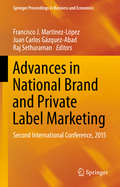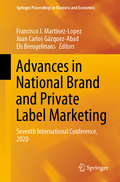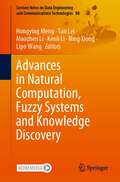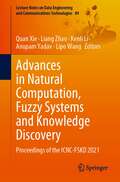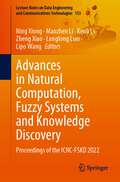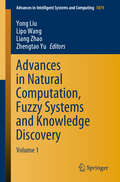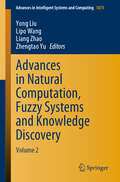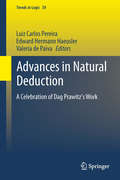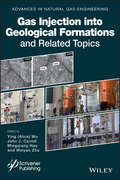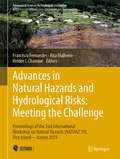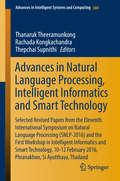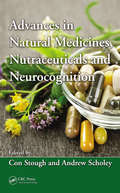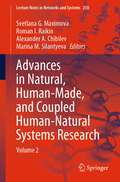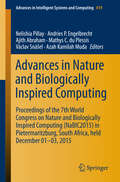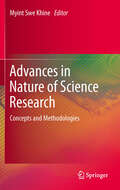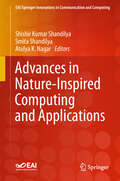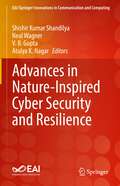- Table View
- List View
Advances in National Brand and Private Label Marketing: Ninth International Conference, 2022 (Springer Proceedings in Business and Economics)
by Francisco J. Martínez-López Juan Carlos Gázquez-Abad Marco IevaThis proceedings volume highlights the latest research presented at the 9th International Conference on Research on National Brand & Private Label Marketing (NB&PL2022). The topics covered include: retailing, private label portfolio and assortment management, private label pricing and promotion, national brand strategies, among other related issues. The volume specifically addresses the needs of researchers and students of advanced marketing courses.
Advances in National Brand and Private Label Marketing: Second International Conference, 2015 (Springer Proceedings in Business and Economics)
by Francisco J. Martínez-López Juan Carlos Gázquez-Abad Raj SethuramanThis book presents the latest research and recent studies in the field of national brand and private label marketing. It covers a wide range of topics, including retailing, marketing, general business, psychology, economics and statistics. It addresses diverse areas of application, such as brand naming and packaging decisions, price elasticity, positioning, branding, consumer motivation, online communities, economic crisis, strategies in growth and mature private labels. The contributions are organized according to the following themes: consumer behaviour, strategic decisions, branding, market trends and theoretical research. The book presents a collection of original, rigorous and relevant contributions from the 2015 National Brands and Private Label Marketing conference in Barcelona.
Advances in National Brand and Private Label Marketing: Seventh International Conference, 2020 (Springer Proceedings in Business and Economics)
by Juan Carlos Gázquez-Abad Francisco J. Martinez-Lopez Els BreugelmansThis proceedings volume highlights the latest research presented at the 7th International Conference on Research on National Brand & Private Label Marketing (NB&PL2020, Barcelona, Spain). The topics covered include: retailing, private label portfolio and assortment management, marketing of premium store brands, using national brands to exclude (delist) and include, optimal assortment size, consumer store patronage, etc. Several contributions also focus on private label pricing and promotion, especially on the relative pricing of standard and premium private labels, and with regard to the national brands in the assortment. Further questions addressed here include: Should store brands be promoted? If so, what types of promotion should be used? How can private label penetration, especially premium private labels, best be dealt with? Are dual branding and coupons viable options?
Advances in National Brand and Private Label Marketing: Sixth International Conference, 2019 (Springer Proceedings in Business and Economics)
by Francisco J. Martínez-López Juan Carlos Gázquez-Abad Anne RoggeveenThe 2019 International Conference on National Brand & Private Label Marketing is a unique academic forum for presenting and discussing original, rigorous and significant contributions from researchers around the world on marketing issues that retailers, store brand managers and national brand managers are facing.The three-day event covered a wide range of topics from varied fields including retailing, marketing, general business, psychology, economics and statistics. Further, it addressed diverse areas of application such as innovation, retail market structure, social media, consumer decision-making, store loyalty, assortment size, digital transformation, ethical aspects, cultural dimensions, and private label pricing. This volume gathers the proceedings of the 2019 NB&PL marketing conference in a collection of outstanding contributions that employ a wide variety of theoretical and methodological approaches.
Advances in National Brand and Private Label Marketing: Third International Conference, 2016 (Springer Proceedings in Business and Economics)
by Francisco J. Martínez-López Juan Carlos Gázquez-Abad Els GijsbrechtThis book presents the latest research on national brand and private label marketing, in the form of original, rigorous and relevant contributions from the 2016 National Brands and Private Label Marketing conference in Barcelona. It covers retailing-related topics, such as brand naming and packaging decisions, price elasticity, positioning, branding, consumer behavior, economic crisis, strategies in growth, and mature private labels.
Advances in Natural Computation, Fuzzy Systems and Knowledge Discovery (Lecture Notes on Data Engineering and Communications Technologies #88)
by Kenli Li Ning Xiong Lipo Wang Maozhen Li Hongying Meng Tao LeiThis book consists of papers on the recent progresses in the state of the art in natural computation, fuzzy systems and knowledge discovery. The book is useful for researchers, including professors, graduate students, as well as R & D staff in the industry, with a general interest in natural computation, fuzzy systems and knowledge discovery. The work printed in this book was presented at the 2020 16th International Conference on Natural Computation, Fuzzy Systems and Knowledge Discovery (ICNC-FSKD 2020), held in Xi'an, China, from 19 to 21 December 2020. All papers were rigorously peer-reviewed by experts in the areas.
Advances in Natural Computation, Fuzzy Systems and Knowledge Discovery: Proceedings of the ICNC-FSKD 2021 (Lecture Notes on Data Engineering and Communications Technologies #89)
by Anupam Yadav Liang Zhao Kenli Li Lipo Wang Quan XieThis book consists of papers on the recent progresses in the state of the art in natural computation, fuzzy systems and knowledge discovery. The book can be useful for researchers, including professors, graduate students, as well as R & D staff in the industry, with a general interest in natural computation, fuzzy systems and knowledge discovery. The work printed in this book was presented at the 2021 17th International Conference on Natural Computation, Fuzzy Systems and Knowledge Discovery (ICNC-FSKD 2021, 24–26 July 2021, Guiyang, China). All papers were rigorously peer-reviewed by experts in the areas.
Advances in Natural Computation, Fuzzy Systems and Knowledge Discovery: Proceedings of the ICNC-FSKD 2022 (Lecture Notes on Data Engineering and Communications Technologies #153)
by Kenli Li Ning Xiong Zheng Xiao Lipo Wang Maozhen Li Longlong LiaoThis book consists of papers on the recent progresses in the state of the art in natural computation, fuzzy systems, and knowledge discovery. The book is useful for researchers, including professors, graduate students, as well as R & D staff in the industry, with a general interest in natural computation, fuzzy systems, and knowledge discovery. The work printed in this book was presented at the 2022 18th International Conference on Natural Computation, Fuzzy Systems, and Knowledge Discovery (ICNC-FSKD 2022), held from 30 July to 1 August 2022, in Fuzhou, China. All papers were rigorously peer-reviewed by experts in the areas.
Advances in Natural Computation, Fuzzy Systems and Knowledge Discovery: Volume 1 (Advances in Intelligent Systems and Computing #1074)
by Yong Liu Liang Zhao Zhengtao Yu Lipo WangThis book discusses the recent advances in natural computation, fuzzy systems and knowledge discovery. Presenting selected, peer-reviewed papers from the 15th International Conference on Natural Computation, Fuzzy Systems and Knowledge Discovery (ICNC-FSKD 2019), held in Kunming, China, from 20 to 22 July 2019, it is a useful resource for researchers, including professors and graduate students, as well as R&D staff in industry.
Advances in Natural Computation, Fuzzy Systems and Knowledge Discovery: Volume 2 (Advances in Intelligent Systems and Computing #1075)
by Yong Liu Liang Zhao Zhengtao Yu Lipo WangThis book discusses the recent advances in natural computation, fuzzy systems and knowledge discovery. Presenting selected, peer-reviewed papers from the 15th International Conference on Natural Computation, Fuzzy Systems and Knowledge Discovery (ICNC-FSKD 2019), held in Kunming, China, from 20 to 22 July 2019, it is a useful resource for researchers, including professors and graduate students, as well as R&D staff in industry.
Advances in Natural Deduction: A Celebration of Dag Prawitz's Work (Trends in Logic #39)
by Luiz Carlos Pereira Edward Hermann Haeusler Valeria De PaivaThis collection of papers, celebrating the contributions of Swedish logician Dag Prawitz to Proof Theory, has been assembled from those presented at the Natural Deduction conference organized in Rio de Janeiro to honour his seminal research. Dag Prawitz's work forms the basis of intuitionistic type theory and his inversion principle constitutes the foundation of most modern accounts of proof-theoretic semantics in Logic, Linguistics and Theoretical Computer Science. The range of contributions includes material on the extension of natural deduction with higher-order rules, as opposed to higher-order connectives, and a paper discussing the application of natural deduction rules to dealing with equality in predicate calculus. The volume continues with a key chapter summarizing work on the extension of the Curry-Howard isomorphism (itself a by-product of the work on natural deduction), via methods of category theory that have been successfully applied to linear logic, as well as many other contributions from highly regarded authorities. With an illustrious group of contributors addressing a wealth of topics and applications, this volume is a valuable addition to the libraries of academics in the multiple disciplines whose development has been given added scope by the methodologies supplied by natural deduction. The volume is representative of the rich and varied directions that Prawitz work has inspired in the area of natural deduction.
Advances in Natural Fibre Composites: Raw Materials, Processing and Analysis
by Sohel Rana Raul FangueiroThis book presents selected high-quality research papers submitted to ICNF 2017, the 3rd International Conference on Natural Fibers, which was held in Braga, Portugal, on 21-23 June 2017. It discusses the latest research and developments in the field and covers a wide range of topics related to various aspects of natural-fiber composites, such as production and processing of raw materials, surface modification and functionalization, advanced fibrous structures for composites, nano fibers, experimental characterization, modeling and analysis, design and product development, applications, market potential, and environmental impacts. The book presents the latest research work addressing different approaches and techniques to improve processing, performance, functionalities and cost-effectiveness of natural-fibers composites, in order to increase their applications in different industrial sectors such as automobiles, transportation, construction, and sport. &
Advances in Natural Gas Engineering
by John J. Carroll Weiyao Zhu Alice Wu Mingqiang HaoThis is the eighth volume in the series, Advances in Natural Gas Engineering, focusing on gas injection into geological formations and other related topics, very important areas of natural gas engineering. This volume includes information for both upstream and downstream operations, including chapters detailing the most cutting-edge techniques in acid gas injection, carbon capture, chemical and thermodynamic models, and much more. Written by some of the most well-known and respected chemical and process engineers working with natural gas today, the chapters in this important volume represent the most state-of-the-art processes and operations being used in the field. Not available anywhere else, this volume is a must-have for any chemical engineer, chemist, or process engineer in the industry. Advances in Natural Gas Engineering is an ongoing series of books meant to form the basis for the working library of any engineer working in natural gas today.
Advances in Natural Hazards and Hydrological Risks: Proceedings of the 2nd International Workshop on Natural Hazards (NATHAZ'19), Pico Island—Azores 2019 (Advances in Science, Technology & Innovation)
by Helder I. Chaminé Francisco Fernandes Ana MalheiroThis book gathers the proceedings of the 2nd International Workshop on Natural Hazards (NATHAZ'19), held in Lajes do Pico, Pico Island, Azores in 2019. Natural hazards constitute the threat of a naturally occurring event having a negative effect on human beings. These effects are often called natural disasters. Among the natural hazards and potential disasters to be considered are: earthquakes, volcanic eruptions, landslides, subsidence, floods, droughts and coastal erosion. In addition, there are anthropogenic hazards that occur as a result of human interactions with the environment. They include technological hazards, which occur due to exposure to hazardous substances in the environment. Grasping the behaviour of natural systems requires a comprehensive understanding of climatology, geology and hydrology data and dynamics. Thus, it is important to conduct hazard and risk assessment studies for meaningful hazard mitigation. Further, the book demonstrates that an accurate understanding of natural systems and interactions between engineering and natural resources is of vital significance to the entire socio-economic sector. This volume offers an overview of natural hazards in model regions in Europe, America, and Atlantic islands. Providing new insights on the characterisation, assessment, protection and modelling of geological hazards, water systems, urban areas and coastal zones, it represents a valuable resource for all researchers and practitioners in the fields of Geosciences, Hydrology, Water Resources, Natural Hazards, Environments and Engineering. Main topics include:1. Natural Hazards and Disasters2. Sustainable Water Systems and Climate Change3. Technological Hazards and Engineering Design
Advances in Natural Hazards and Volcanic Risks: Proceedings of the 3rd International Workshop on Natural Hazards (NATHAZ’22), Terceira Island—Azores 2022 (Advances in Science, Technology & Innovation)
by Helder I. Chaminé Francisco Fernandes Ana MalheiroThis book comprises the selected proceedings of the 3rd International Workshop on Natural Hazards (NATHAZ’22), Angra do Heroísmo, Terceira Island, Azores, 2022. The book interests all researchers and practitioners in Earth Sciences, Volcanic Risks, Natural Hazards, Geoethics, Environmental Sciences and Engineering. Terceira is a volcanic island with volcanic systems with caldera (Cinco Picos, Guilherme Moniz, Santa Bárbara and Pico Alto central volcanoes) and an active fissural zone defined by various alignments of small volcanic cones, lava domes and fault zones. The agricultural landscape, the natural and forest reserve, as well as the natural pools make the island a unique place to visit. The historic downtown of Angra do Heroísmo is a UNESCO world heritage, and several iconic buildings witness the island’s geodynamic history. Natural hazards result from a threat of a naturally occurring event that will have a negative effect on humans. That damaging effect is often called natural disasters. Among the natural hazards and potential disasters to be considered are: earthquakes, volcanic eruptions, landslides, subsidence, floods, droughts and coastal erosion. In addition, anthropogenic hazards occur as a result of human interaction with the environment. They comprise technological risks due to exposure to hazardous substances in the environment. Natural systems in different frameworks require a comprehensive understanding of climatology, geology, hydrology and volcanic data, processes and dynamics. Thus, it is important to perform hazard and risk assessment studies to accomplish hazard mitigation. In addition, it highlighted the role of variability and climate change in Earth systems. Furthermore, an accurate understanding of the natural systems and interactions with engineering, geodiversity and natural resources is vital to the entire socioeconomic sector. This book is expected to offer an overview of natural hazards in model regions in Europe, America, Asia and the Atlantic islands. It gives new insights into the characterization, assessment, protection, and modelling of geological hazards, volcanic systems, urban areas, coastal zones and engineering approaches by international researchers and professionals. The scientific committee comprises lead geoscientists, natural hazards related practitioners, and academics worldwide. The main topics include: 1. Multi-hazards and risks: sustainable society, disasters and geoethics 2. Natural hazards and assessment: rock falls, landslides, urban planning and management 3. Sustainable Earth systems: hazards and climate change 4. Terceira Island geology and geodiversity: meeting volcanological hazards in the Azores
Advances in Natural Language Processing, Intelligent Informatics and Smart Technology: Selected Revised Papers From The Eleventh International Symposium On Natural Language Processing (snlp-2016) And The First Workshop In Intelligent Informatics And Smart Technology (Advances In Intelligent Systems And Computing #684)
by Thanaruk Theeramunkong Thepchai Supnithi Rachada KongkachandraThis book presents the latest research on national brand and private label marketing - a collection of original, rigorous and highly relevant contributions of the 2017 International Conference on National Brand & Private Label Marketing in Barcelona. It covers a wide range of topics from fields as varied as retailing, marketing, general business, psychology, economics and statistics. Further, the conference addressed diverse areas of application, including: purchase-decision models, premium private labels, decisions involved in introducing new products, M-commerce, private label adoption, assortment decisions, private label pricing, brand equity and collaborative relationships.
Advances in Natural Medicines, Nutraceuticals and Neurocognition
by Con Stough Andrew ScholeyGreat strides have been made in the field of natural medicine with respect to neurocognition. Once limited to the province of niche publications, these discoveries are now routinely explored in mainstream psychopharmacology, neuroscience, nutrition, and medical journals. Now presented in one convenient volume, Advances in Natural Medicines, Nutrace
Advances in Natural Polymers: Composites and Nanocomposites (Advanced Structured Materials #18)
by Sabu Thomas P. M. Visakh Aji. P MathewThe book summarizes in a comprehensive manner many of the recent technical research accomplishments in the area of natural polymers. It discusses the various attempts reporting on solving this problem from the point of view of the chemistry and the structure of natural polymers, highlighting the drawbacks and advantages of each method and proposal. Based on considerations of structure - property relations, it is possible to obtain fibers with improved strength by making use of their nanostructures and/or mesophase properties of natural polymers. The book is a unique book with contributions from the experts of the biomaterial area research. it covers all topics related to natural biomaterials such as natural rubber, cellulose, chitin, starch, hemicellulose, lignin, alginates, soy protein, casein and their bionanocomposites and applications. This book is a useful reference for scientists, academicians, research scholars and biotechnologists.
Advances in Natural, Human-Made, and Coupled Human-Natural Systems Research: Volume 1 (Lecture Notes in Networks and Systems #234)
by Svetlana G. Maximova Roman I. Raikin Alexander A. Chibilev Marina M. SilantyevaThis book is a collection of cutting-edge and cross-disciplinary studies on natural, human-made, and coupled human-natural systems, addressing the challenge of developing integrated knowledge from multiple disciplines. The authors explore the structure, function, and dynamic mechanisms of various systems, both natural and human-made, as well as analyze their reciprocal interactions under the concept of “coupled human-natural systems.” These interactions are used to understand feedback, nonlinearities, thresholds, time lags, legacy effects, and path dependencies, emerging across multiple spatial, temporal, and organizational scales. In other words, this book is a collection of advanced research on unique properties of natural and human-made systems, as well as human-environment dynamics, reciprocal relationships, and cross-scale interactions.The authors outline prospects on building a holistic view of social development and coherent sustainability. Among the topics covered are the following: human networks research; adaptation of local people to social and environmental challenges; coupled dynamics of socioeconomic and environmental systems; critical issues in social science climate change research; education for greater sustainability; peace, justice, and strong institutions; advances in cultural traditions and strategies for social stability; innovative development and barriers to sustainable development; economic systems in the age of digital changes and unstable external environments. The scholars analyze how more effective technologies can enhance resilience, reduce vulnerability, and minimize human impacts on natural systems, taking into consideration critical thresholds to prevent harmful feedback to human systems.The authors grasp the complexity of systems by integrating knowledge of constituent subsystems and their interactions. The framework developed by the authors is used to integrate human and natural systems for achieving greater sustainability, covering critical threats, challenges, and best governance approaches and practices. The research results obtained from studies on coupled human-natural systems are stronger, the authors argue, if compared with traditional (discipline) approaches.
Advances in Natural, Human-Made, and Coupled Human-Natural Systems Research: Volume 2 (Lecture Notes in Networks and Systems #250)
by Svetlana G. Maximova Roman I. Raikin Alexander A. Chibilev Marina M. SilantyevaThis book is a unique collection of advanced research on natural, human-made, and coupled human–natural systems. The contributors analyze the current state of knowledge, address methodological challenges, and explore engaging cases. The chapters demonstrate the balanced disciplinary strength and discuss interdisciplinary perspectives. The authors undertake a holistic and spatially integrative analysis to understand the sustainability of environmental, economic, and social systems, emphasizing the coupled nature of such systems. In particular, the chapters explore biodiversity conservation and natural resources, the sustainability of natural and human-altered ecosystems, sustainability–vulnerability issues in coupled human–natural systems, mechanisms to foster sustainable environmental practices, eventually accumulating sustainability research and practice in various fields. More than that, the challenges of educational and economic systems are studied closely. The authors rely on unique data, develop regional and local knowledge, and explore global trends at local scales. A separate focus is devoted to human health and well-being. The book has seven sections: (1) Advances in Natural and Coupled Human–Natural Systems Research; (2) Economic Systems in the Age of Digital Changes and Unstable Environments; (3) Sustainable Social Systems, Migration Flows, and Social Cohesion; (4) Taking Action for Greater Security and Effective Partnerships for Sustainable Development; (5) Systemic Challenges and Changes in Education Systems in Russia and Around the Globe; (6) Advances in Cultural Traditions and Innovation, Development Barriers, and Social Stability; (7) Human Health and Well-being: Taking Action for Sustainable Development. Written by scholars and practitioners from multiple fields of knowledge, the book is designed for a broader audience interested in the following research areas: systems research and thinking, sustainability research and thinking, system dynamics, management of complexity, decision analysis, organization theory, governance, natural resources, environmental studies, economic development, social policies, cleaner production, innovation, cultural studies, and sustainable practices.
Advances in Natural, Human-Made, and Coupled Human-Natural Systems Research: Volume 3 (Lecture Notes in Networks and Systems #252)
by Svetlana G. Maximova Roman I. Raikin Alexander A. Chibilev Marina M. SilantyevaThis book enables readers to develop a multidisciplinary understanding of natural, human-made, and coupled human-natural systems. The authors explore the structure, function, and dynamic mechanisms of various systems, both natural and human-made, as well as analyze their reciprocal interactions under the concept of “coupled human-natural systems.” The chapters challenge traditional planning and management assumptions and strategies for natural resources, human-altered systems, and the environment.Acknowledging the critical role of effective regulations, policies, and governance structures, the authors analyze advanced research and practices on policy design for managing natural, human-made, and coupled human-natural systems. They conduct impact evaluation and integrative ecosystems assessment, as well as discuss policy interventions and decision-making strategies. They acknowledge the localization of policy design, considering regional and global dynamics that shape responses of local human-made and coupled human-natural systems. A special collection of chapters analyzes legal foundations for sustainable development and strong institution. The authors explore models from both natural and social sciences to obtain and present significant research results.The book is a dispensable source of sustainability research and practice in human-made, natural, and coupled human-natural systems. It is for the scholars, practitioners, and advanced graduate students interested in systems theories, methodologies, and applications.
Advances in Nature and Biologically Inspired Computing: Proceedings of the 7th World Congress on Nature and Biologically Inspired Computing (NaBIC2015) in Pietermaritzburg, South Africa, held December 01-03, 2015 (Advances in Intelligent Systems and Computing #419)
by Ajith Abraham Azah Kamilah Muda Václav Snášel Nelishia Pillay Andries P. Engelbrecht Mathys C. du PlessisWorld Congress on Nature and Biologically InspiredComputing (NaBIC) is organized to discuss the state-of-the-art as well as toaddress various issues with respect to Nurturing Intelligent Computing TowardsAdvancement of Machine Intelligence. This Volume contains the papers presentedin the Seventh World Congress (NaBIC'15) held in Pietermaritzburg, South Africaduring December 01-03, 2015. The 39 papers presented in this Volume werecarefully reviewed and selected. The Volume would be a valuable reference toresearchers, students and practitioners in the computational intelligencefield.
Advances in Nature of Science Research: Concepts and Methodologies
by Myint Swe KhineThis book consolidates contemporary thinking and research efforts in teaching and learning about the nature of science in science education. The term 'Nature of Science' (NoS) has appeared in the science education literature for many decades. While there is still a controversy among science educators about what constitutes NoS, educators are unanimous in acknowledging the importance of this topic as well as the need to make it explicit in teaching science. The general consensus is that the nature of science is an intricate and multifaceted theme that requires continued scholarship. Recent analysis of research trends in science education indicates that investigation of the nature of science continues to be one of the most prevalent topics in academic publications. Advances in Nature of Science Research explores teaching and assessing the nature of science as a means of addressing and solving problems in conceptual change, developing positive attitudes toward science, promoting thinking habits, advancing inquiry skills and preparing citizens literate in science and technology. The book brings together prominent scholars in the field to share their cutting-edge knowledge about the place of the nature of science in science teaching and learning contexts. The chapters explore theoretical frameworks, new directions and changing practices from intervention studies, discourse analyses, classroom-based investigations, anthropological observations, and design-based research.
Advances in Nature-Inspired Computing and Applications (EAI/Springer Innovations in Communication and Computing)
by Atulya K. Nagar Shishir Kumar Shandilya Smita ShandilyaThis book contains research contributions from leading global scholars in nature-inspired computing. It includes comprehensive coverage of each respective topic, while also highlighting recent and future trends. The contributions provides readers with a snapshot of the state of the art in the field of nature-inspired computing and its application. This book has focus on the current researches while highlighting the empirical results along with theoretical concepts to provide a comprehensive reference for students, researchers, scholars, professionals and practitioners in the field of Advanced Artificial Intelligence, Nature-Inspired Algorithms and Soft Computing.
Advances in Nature-Inspired Cyber Security and Resilience (EAI/Springer Innovations in Communication and Computing)
by Atulya K. Nagar Shishir Kumar Shandilya Neal Wagner V. B. GuptaThis book presents a comprehensive reference source for dynamic and innovative research in the field of cyber security, focusing on nature-inspired research and applications. The authors present the design and development of future-ready cyber security measures, providing a critical and descriptive examination of all facets of cyber security with a special focus on recent technologies and applications. The book showcases the advanced defensive cyber security mechanism that is a requirement in the industry and highlights measures that provide efficient and fast solutions. The authors explore the potential of AI-based and nature-inspired based computing compatibilities in establishing an adaptive defense mechanism system. The book focuses on current research while highlighting the empirical results along with theoretical concepts to provide a reference for students, researchers, scholars, professionals, and practitioners in the field of cyber security and analytics. This book features contributions from leading scholars from all over the world.

